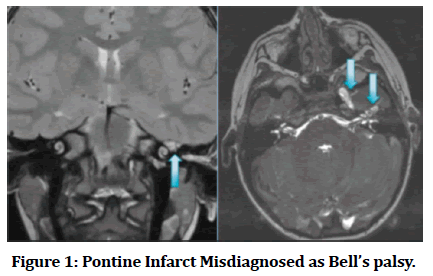Case Report - (2023) Volume 11, Issue 1
A case of Pontine Infarct Misdiagnosed as Bellâs palsy: A Case Report
P Ram Prasaanth*, NN Anand, R Karthik Ramalingam and Nitharsha Prakash
*Correspondence: P Ram Prasaanth, Department of General Medicine, Sree Balaji Medical College and Hospital, Chrompet, Chennai, India, Email:
Abstract
Bell’s palsy most commonly presents as isolated facial nerve palsy. A rare cause of isolated facial nerve palsy is lacunar infarct involving the pons. Our case who presented with facial nerve palsy was initially seemed to have bell’s palsy but later found to have infarct in pontine.
Keywords
Bell’s palsy, Unilateral facial expression, Pontine infarct, Facial nerve, Lacunar infarct
Introduction
Isolated palsy of facial nerve most commonly appears as Bell’s palsy. Bell’s palsy presents with sudden onset facial nerve palsy which usually resolves within 6 months. Lacunar infarct also presents with solitary facial palsy [1].
Case Presentation
A 42 years old hypertensive from chengalpattu came to the general medicine department with nausea, fatigue, facial muscle weakness, vomiting and speech slurring for past 20 hours. On examination patient is conscious, drowsy and with speech slurring. BP of the patient was found to be 220/140 mmHg with HR having 110 bpm. On examination of CNS there was absence of left sided forehead creases, left eye was unable to be closed, weakness of facial muscles on left side, angle of the mouth deviation to the right on smiling and absence of nasolabial fold on left side. Afferent reflexes of cornea on both sides were intact. Other cranial nerves were normal with no involvement [2].
Intracranial haemorrhage has been ruled out by CT scan (Computed Tomography). The initial MRI of head, turned out to be negative for acute stroke. The differential diagnosis is Bell’s palsy but because of acute presentation of symptoms it is less likely, on imaging there was encephalopathy and the patient was hypertensive [3]. On revaluation of MRI there was restricted diffusion of 3.5 mm over the left dorsal aspect of pons, consistent with small ischemic infarct. The probable diagnosis was isolated palsy of facial nerve since there was lacunar infarction over the dorsal pons and hypertensive encephalopathy. A trial sepal defect with bidirectional shunt on transesophageal echo cardiogram. Continuous BP monitoring is done and treatment started with aspirin, coumadin and heparin therapy for rare occurrence of a paradoxical embolism (Figure 1).
Figure 1: Pontine Infarct Misdiagnosed as Bell’s palsy.
Discussion
The facial nerve is one of the cranial nerve with a both sensory and motor component. The motor component is responsible for unilateral facial expression because of its supply to the concerned muscles. Anatomical localization and clinical correlation of the nerve is important [4]. Bell’s palsy is the commonest cause of facial palsies, tumours and pontine infarcts also manifests as facial palsy. Among all ischemic strokes 7% are pontine infarcts and of all posterior circulation infarcts 15% was found to be isolated pontine strokes [5]. They are usually lacunar infarcts involving the perforators of basilar artery and other small vessels of posterior circulation, with risk factor of high blood pressure. MRI Diffusion Weighted Imaging (DWI) better than CT in identification of ischemic stroke that are acute, but DWI can also give false negative results in the first 24 hours of presentation [6]. Strokes of the posterior circulation involved region are more common for false negative results including the brainstem. In a case report MRI finding was negative within the first 24 hours of onset, MRI which was repeated after 24 hours of presentation helped in identifying such lesions which are negative on MRI initially [7].
Very rarely Isolated ischemia of dorsal pontine presents as isolated palsy of facial nerve ,and only one previously reported case as for now is reported. Our case concludes that isolated palsy of facial nerve not to be taken as Bell’s palsy always. As observed in our patient it is a rare dorsal pontine infarct.
Conclusion
Very rarely Isolated ischemia of dorsal pontine presents as isolated palsy of facial nerve and only one previously reported case as for now is reported. Our case concludes that isolated palsy of facial nerve not to be taken as Bell’s palsy always. As observed in our patient it is a rare dorsal pontine infarct.
References
- Agarwal R, Manandhar L, Saluja P, et al. Pontine stroke presenting as isolated facial nerve palsy mimicking Bell's palsy: A case report. J Med Case Rep 2011; 5:287. [Crossref][Googlescholar][Indexed]
- Holland NJ, Weiner GM. Recent developments in Bell's palsy. BMJ 2004; 329:553-557. [Crossref][Googlescholar][Indexed]
- Bassetti C, Bogousslavsky J, Barth A, et al. Isolated infarcts of the pons. Neurol 1996; 46:165-175. [Crossref][Googlescholar][Indexed]
- Agarwal R, Manandhar L, Saluja P, et al. Pontine stroke presenting as isolated facial nerve palsy mimicking Bell's palsy: A case report. J Med Case Rep 2011; 5:287. [Crossref][Googlescholar][Indexed]
- Saia V, Pantoni L. Progressive stroke in pontine infarction. Acta Neurol Scand 2009; 120:213-215. [Crossref][Googlescholar][Indexed]
- Ling L, Zhu L, Zeng J, et al. Pontine infarction with pure motor hemiparesis or hemiplegia: A prospective study. BMC neurol 2009; 9:25. [Crossref][Googlescholar][Indexed]
- Oppenheim C, Stanescu R, Dormont D, et al. False negative diffusion weighted MR findings in acute ischemic stroke. Am J Neuroradiol 2000; 21:1434-1440. [Googlescholar][Indexed]
Author Info
P Ram Prasaanth*, NN Anand, R Karthik Ramalingam and Nitharsha Prakash
Department of General Medicine, Sree Balaji Medical College and Hospital, Chrompet, Chennai, IndiaCitation: P Ram Prasaanth, NN Anand, R Karthik Ramalingam, Nitharsha Prakash, A case of Pontine Infarct Misdiagnosed as Bell’s palsy: A Case Report, J Res Med Dent Sci, 2023, 11 (1):294-295
Received: 29-Aug-2022, Manuscript No. JRMDS-22-75747; , Pre QC No. JRMDS-22-75747 (PQ); Editor assigned: 01-Sep-2022, Pre QC No. JRMDS-22-75747 (PQ); Reviewed: 15-Sep-2022, QC No. JRMDS-22-75747; Revised: 03-Jan-2023, Manuscript No. JRMDS-22-75747 (R); Published: 16-Jan-2023

